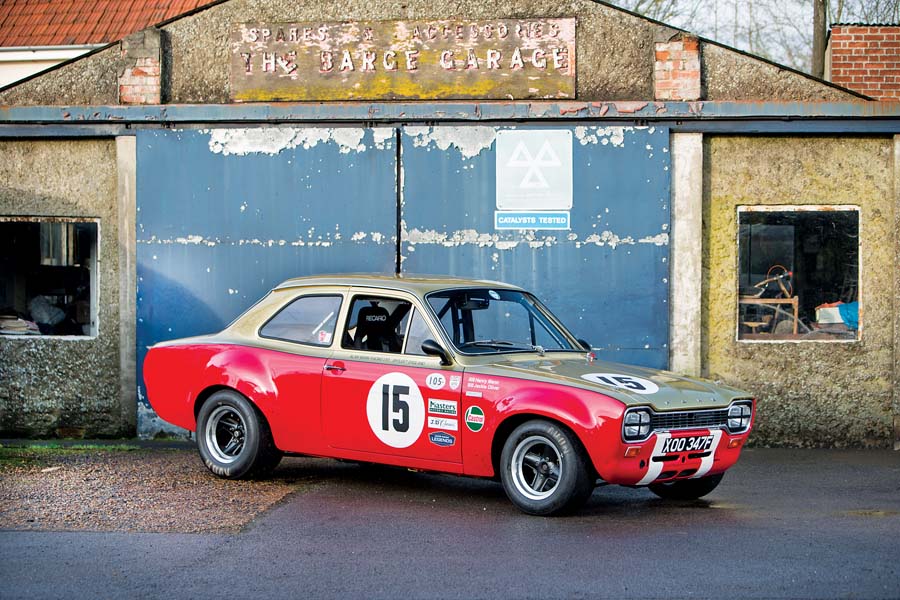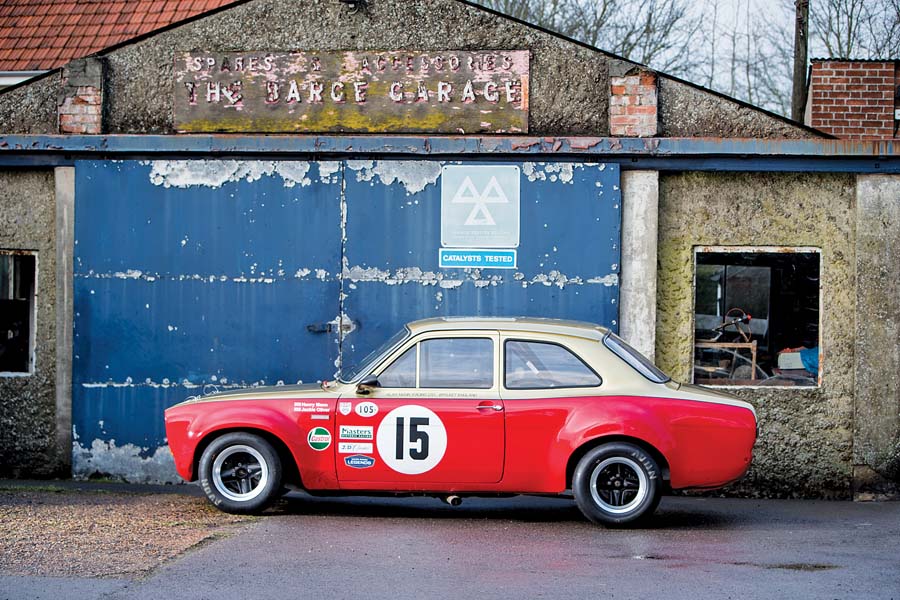SCM Analysis
Detailing
| Vehicle: | 1968 Ford Escort Twin-Cam competition saloon |
| Years Produced: | 1968 |
| Number Produced: | Six |
| Original List Price: | N/A |
| SCM Valuation: | $185,985 |
| Chassis Number Location: | Plate on right inner wing |
| Engine Number Location: | Left rear of block near sump flange |
| Club Info: | Ford AVO Owners Club |
| Website: | http://www.avoclub.com |
| Alternatives: | 1963–70 Lotus Cortina, 1965–71 Alfa Romeo GTA, 1964 Ford Falcon Sprint (or 1968 BMW 2002 tii if you include ETCC) |
| Investment Grade: | B |
This car, Lot 11, sold for £203,100 ($251,034), including buyer’s premium, at Bonhams’ Goodwood Members’ Meeting sale on March 19, 2017.
Famous English cars are universally known by their registrations.
After FEV 1H, the 1970 London-Mexico rally winner, the Alan Mann racers in their distinctive red and gold livery are the most famous Escorts of all — all in the sequence XOO 344 to 349F. You could even get them as Scalextric racers.
Our subject car, “347,”has had quite a history. One of six 1100Ls delivered to Alan Mann Racing, it was built up into a racer with much trickery. The trickiest part was the Len Bailey-designed suspension, which better located the wheels, reduced camber change in roll at the front and — presumably — made changing springs and anti-roll bars quicker.
At the front, instead of the normal MacPherson struts with short track control arms, there are longer TCAs on a bespoke cross member that also houses the steering rack, located fore/aft by compression struts as used on early Escorts. The original MacPhersons were retained — but only to locate the wheel. Separate, inboard-mounted coils over Öhlins dampers did the actual springing.
At the rear was a coil-and-torsion-bar-sprung four-link setup — plus a unique forward-facing Watt linkage arrangement.
The wheelarches were extended, the rears wearing uniquely large blisters to cover massive rear tires. The cars originally ran Minilite wheels over disc brakes all round. Rather than the 1,558-cc Twin Cam, power came from the 1,594-cc FVA — a Formula 2 engine with gear-driven cams, which was a tryout for the DFV, sharing a similar head design.
As far as I can tell, all the body shells had left-hand-drive wiper setups, allowing them to run a single wiper almost centrally placed.
Success, heater fans and no roll cages
The cars were massively successful, with Frank Gardner winning the 1968 British Saloon Car Championships in 349.
Judging from race results, 347 — our subject car — appears to have been a spare car only sent out near the end of the season — each time “supercharged” to bounce it up to the big class in an attempt to spoil the chances of the 289 Ford Falcons.
Jackie Oliver drove it twice, at Croft and Brands Hatch, beating Frank Gardner both times. Oliver’s best result in 347 was at Brands’ Evening News Trophy meet on September 2, 1968, when he finished 2nd behind the race-winning Falcon of Roy Pierpoint, although Gardner’s 4th place was enough to clinch the championship.
The previous month they had finished 3-4 in both of two heats at Croft, Oliver’s car beating 349 both times. The “supercharging” was apparently by heater fan inside the induction system to satisfy the rules. Over time, that legend has become “supercharged by hairdryer.”
Scarily, period pictures show that all this race action was before the adoption of roll cages.
Jackie Oliver doesn’t recall anything about the supercharging. “They never told us anything — the driver was just another nut behind the wheel,” he said, but he vividly remembers destroying the first finished car (345) in testing at Goodwood as it barrel-rolled coming out of Fordwater.
On Oliver’s office wall is a picture of him racing 347 at Brands in 1968, which helps tie him to our subject car. However, it’s possible the team swapped number plates around depending on which cars were ready to go, which was a common practice back in the day.
Racing around the world
After the Alan Mann team had completed the 1969 British Championship season with Frank Gardner in 349 (fitted with a Twin Cam engine), the remaining five cars were returned to Ford at Boreham.
Don Moore ran 347 in Shell colors for Gillian Fortescue-Thomas in U.K. national races in 1972 as a test mule for the new alloy-block Cosworth BDA engine at 2,060 cc and 260 bhp.
In 1973, Alec Poole purchased the Escort, fitted with a new fuel-injected 1,800-cc BDA, and shipped it to Guyana. Poole raced the car in 1974 and sold it on to Harry Watkins in 1975.
In 1977, 347 went to Trinidad. In 2010, noted Barbadian rally driver Greg Cozier found the car and shipped it back to the U.K. for restoration. As found, Cozier said, it had no engine and a Broadspeed-type, six-link rear end, using an Atlas (German) axle rather than the original English type.
A massive restoration
John Mitchell then bought it and commenced a meticulous rebuild of the car to its original 1968 Group 5 specification. The car was also fitted with a modern roll cage, seat, a harness dated to 2019, fuel cell and a fire-extinguishing system to meet current FIA regulations. In addition, modern instruments, including a 12,000-rpm Smiths tachometer, were fitted.
Power now comes from a new Geoff Richardson-built FVA making 240 bhp — against the advertised 215 bhp in period. The stated weight of 878 kg (1,935 pounds) is believable. My all-steel 2-door Mk 1 with 2-liter Pinto and Type 9 5-speed — but less in the way of wheels, suspension and brakes — weighs 900 kg (1,984 pounds).
Alan Mann’s son Henry, who now runs Alan Mann Racing, confirms that “the rear suspension is as it was in period, its coil springs, torsion bars, a four-link and Watts linkage. The components under there now are not original, but remanufactured to original spec. The front sliding pillar struts, however, are the original ones.
“All the suspension was designed by Len Bailey, and made in house at Alan Mann Racing for the ’68 season. The torsion bars came from a Morris Minor and sit in front of the axle and just above, mounted into the chassis via a splined drop link. With all that going on under there, and running 10-inch slicks, we had trouble with the axle casing flexing and popping the oil seals!”
Back on the track
Alan Mann passed away in 2012 — but not before he had confirmed the car’s originality.
After the restoration was completed in June 2014, Henry Mann ran the car at the 2014 Goodwood Festival of Speed, taking the fastest time in the Pre-’82 Touring Car Class.
At Goodwood, the car presented beautifully, with neatly printed signs stuck all over the back end imploring no one to push on the fragile rear arches.
The “eyebrow” over the left headlight was a little misaligned, but it appears to have been like that since restoration. It happens if the wing gets a little tweak in the front, and they then distort.
Aside from the modern safety gear and instruments, about which we can’t complain if we want to see the car actually being used, it ran a set of four-spoke Revolution wheels instead of black-painted Minilites. However, procuring a set of Minilites shouldn’t be too difficult to get the perfect period look.
The car appeared to sit a little higher at the back than in period, wearing slightly smaller rubber.
This sale took place at Goodwood’s 75th Members’ Meeting. After a £120k start and following a brief hiatus at £175k, a massive surge of engine roar swelling over from the starting grid reignited bidding and just tipped it over the reserve to the point, where it was on sale at £180k. That was a little way under its £200k pre-auction estimate, but that’s understandable when you compare it to 349, which is almost unchanged from when it won the championship in 1968.
Our subject car isn’t quite the Holy Grail. Even though it’s a real car, it’s not as original as 349, and its interesting history will taint its value compared with the championship winner.
I’d love to be able to say this was the “supercharged” car – it almost certainly is, but even with that picture, nobody can definitely prove it.
What really mattered, though, is that it was available, and 349 is not. The new owner gets the real thing to play with. The seller has enjoyed owning a proper and potent Alan Mann racer — and probably got most of his money back.
I’d say all parties came out of this pretty well. ♦
(Introductory description courtesy of Bonhams.)

